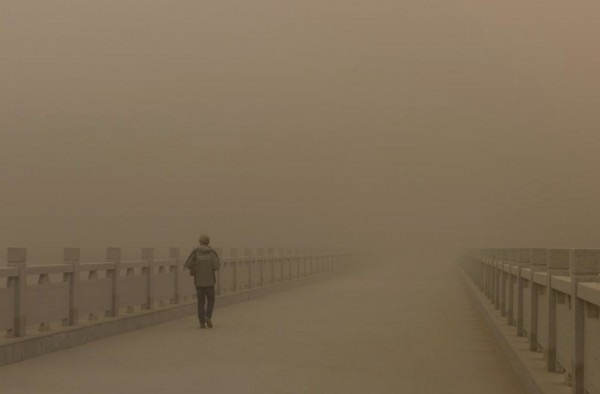Notes
Spring Time in the Dust Bowl
It’s that time of year when we can enjoy the annual photographs of cherry blossoms, tulips, and daffodils; not to mention birds building their nests while lambs and puppies and babies delight in the warm spring sunshine. Winter has finally moved on, and hope springs eternal.
Unless, of course, you are caught in a dust storm in Dunhuang, China. I realize that we are all too familiar with the dust storms of Dunhuang, but let me bring up the subject one more time. Yes, I want to introduce a sour note into the seasonal chorus, and no, it’s not something I usually do. You shouldn’t blame me anyway, because it’s this photograph’s fault.
Any part of the planet can have a bad day, and I don’t want to single out Gansu province, which would be a tad hypocritical when my own country is dealing–and not dealing–with a drought and other adverse weather that of course has nothing to do with climate change. And like most photographs, the value of this image really isn’t in its news value, but rather in how it helps to orient us toward conditions that we already are experiencing.
To that end, this photo’s artistry provides at least three suggestions that merit further reflection. One is how all-encompassing the storm is. Of course, that is an illusion created by the limited purview of the camera: somewhere outside of the frame, there is no dust storm. But in the scene we see, which extends to the horizon, the dust is sovereign. It doesn’t take much imagination to see that total transformation of the local environment as the result of enormous natural forces. This incredible feat of lifting thousands of tons of earth into the air is the work of vast weather systems wheeling about the globe. In case it wasn’t clear enough, consider also the contrast with the human being walking through the storm. He can endure it, wait it out, survive it, talk about it afterwards, but he cannot control or conquer it.
The second suggestion comes from that high-quality fence. This is not your grandfather’s dust bowl. The beautiful design may be made of concrete–that is, of sand, a silicone dust–but in any case it sits serenely in the storm, almost as if it, too, could patiently wait it out. The omnipresent tonality of the photo creates a homology between the dust storm and the patterned roadway, as if the built environment and the natural environment were seamlessly coordinated (in harmony, the Chinese might say). And there is an important moral there, I think: if the dust all blows away, or if it grinds the structure down to dust, or if it gently buries it 100 feet underground, it’s all the same to the dust and to the structure. The continuity of nature and human engineering that we rightly prize, works just as well in reverse.
Which brings us to the third design element in the composition. Both roadway and the lone individual are directed toward the vanishing point of the photograph: a place in this image of pure obliteration. Sight, distinction, every separate thing is consumed by the storm, converted into total meaninglessness like a last, uniform expanse of cosmic dust at the far end of time. Against the hubris that comes with building beautiful structures and complex civilizations, we see instead a trajectory toward a common dissolution.
This photograph doesn’t tell us anything important that we don’t know, but it does provide the means to think about what we would rather ignore. When it comes to living on this planet, just who are we kidding, and what do we think will save us? There have been dust storms for a very long time, and they have buried more than one civilization, but now the stakes are higher still. Human beings are able to alter the climate, but not control it. What had been local problems or long term patterns can be tipped into catastrophic changes. And if hope springs eternal, then there will be reason to believe that one day we’ll all be there, walking along a beautifully engineered roadway into oblivion.
— Robert Hariman
(cross-posted from No Caption Needed)
(photo: China Stringer Network/Reuters)



Reactions
Comments Powered by Disqus